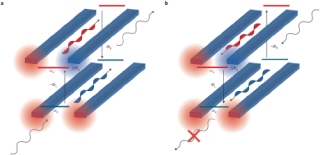Sep 11 2014
In electronics, changing the path of electrons and manipulating how they flow is as easy as applying a magnetic field.
 An illustration of the nonreciprocity of the dynamics of light propagating in the forward (a) and the backward (b) direction. Credit: Nature Photonics
An illustration of the nonreciprocity of the dynamics of light propagating in the forward (a) and the backward (b) direction. Credit: Nature Photonics
Not so for light. “We don’t have such a thing for light,” said Michal Lipson, professor of electrical and computer engineering. “For the majority of materials, there is no such thing as something I can turn on, and apply this magic field to change the path of light.”
Until now. Lipson, a leader in the emerging field of silicon photonics – sending light through waveguides instead of currents through wires – and colleagues have shown that an equivalent field for light does exist. Experiments led by graduate student Lawrence Tzuang, in collaboration with Paulo Nussenzveig of University of Sao Paulo and Kejie Fang and Shanhui Fan from Stanford University, are described in a recent issue of Nature Photonics.
This effective magnetic field has to do with the light’s phase, which is a measure of a particular point in a light wave’s cycle, quantified as an angle in degrees.
The researchers demonstrated the existence of this field with an experimental interferometer, a micron-scale device with two modulators that send light waves back and forth between them.
When a light wave travels under normal conditions, its phase is proportional to how far it traveled, but it is unaffected by what path it has taken. Just like a magnetic field causes a current to switch direction, the researchers showed that by modulating the light with their device, they could make the phase of the light change not only as a function of distance traveled, but also by the shape of its path.
An array of such modulators would be powerful enough to create a field for light that is equivalent to the magnetic field for electrons; phases of light could be controlled arbitrarily by each of the modulators. This means that the phase of transmitted light could depend on the path it has taken from point A to point B, Lipson explained.
“That puts us very close to what electrons do in a magnetic field; they experience exactly that in a magnetic field: The phase accumulated in their trajectory depends on the exact path they have taken,” Lipson added.
Lipson and colleagues dream of controlling light at the smallest scales and in the most fundamental ways, using optics instead of wires on circuits to revolutionize electronics. Reaching this goal depends on the ability to propagate and control light in nontraditional ways, of which the Nature Photonics work is an example.
“One could in principle make fabrics of similar devices that would imprint phase and control the path of light in ways you couldn’t conceive before,” Lipson said.
Supporters of the research include the National Science Foundation and the Kavli Institute at Cornell for Nanoscale Science. The interferometer was fabricated at the Cornell Nanoscale Science and Technology Facility, also supported by the National Science Foundation.